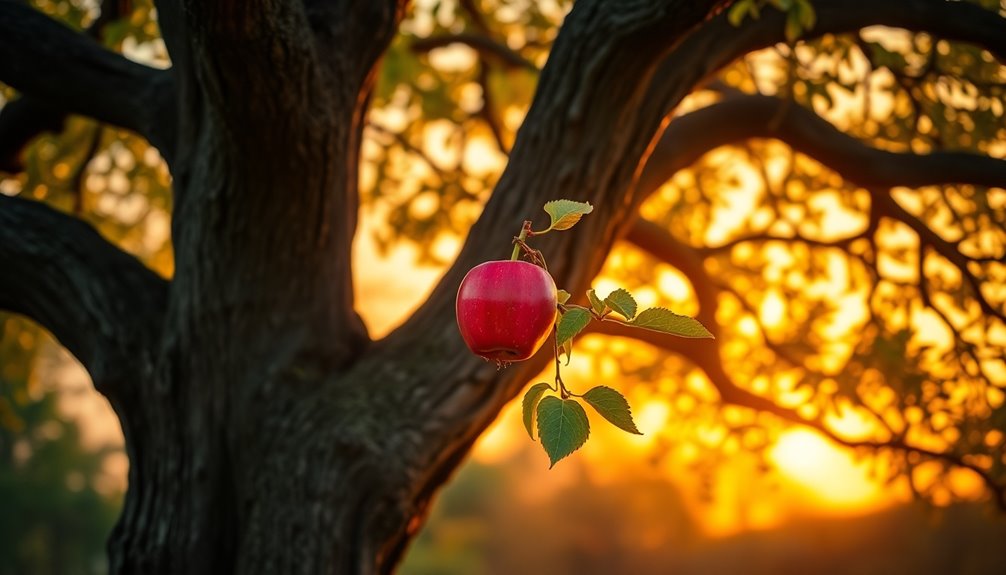The pomegranate is an exciting fruit that symbolizes life, fertility, and renewal in many cultures. In Greek mythology, it's linked to Persephone, representing the cycle of life and seasons. This vibrant fruit is also seen as a symbol of abundance and hope, with its many seeds reflecting opportunities for growth. In Jewish tradition, it's important for its connection to spiritual teachings. You'll find pomegranates celebrated in various art and literature, where they capture themes of love and complexity. So, if you're curious about how exactly pomegranates impact cultures today, there's even more to discover!
Key Takeaways
- The pomegranate symbolizes life, death, and rebirth, notably linked to Persephone in Greek mythology.
- It represents fertility and femininity, often featured in wedding rituals across various cultures.
- In Jewish tradition, its 613 seeds symbolize the 613 commandments of the Torah, highlighting moral duties.
- The fruit embodies empowerment and spiritual awakening, challenging traditional notions of femininity and sexuality.
- In art and literature, pomegranates signify abundance, temptation, and the duality of life and death.
Mythological Significance
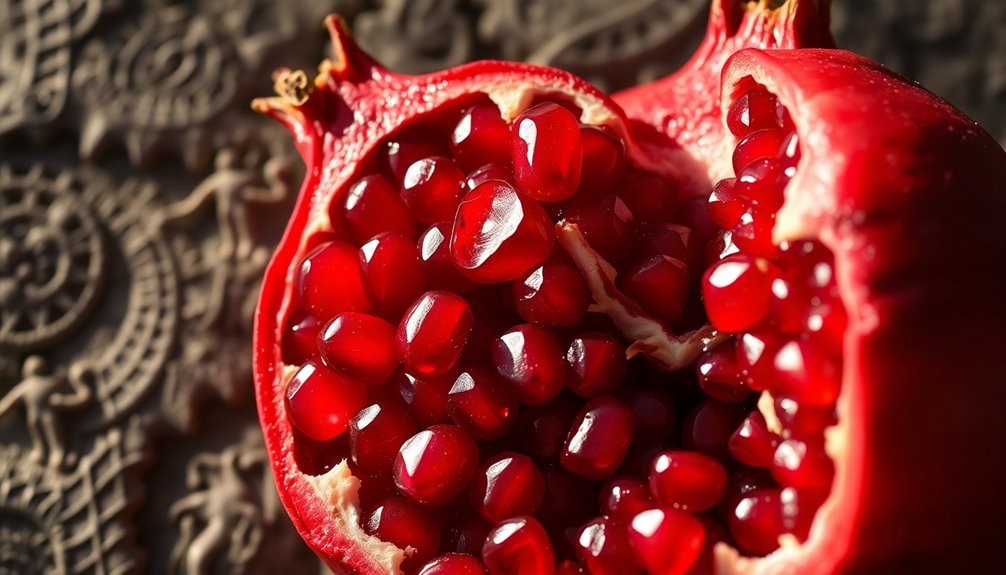
The pomegranate's mythological significance is deeply rooted in various cultures and narratives. You might find it fascinating that in Greek mythology, the pomegranate is tied to the story of Persephone. When she eats its seeds, it binds her to Hades, the god of the underworld. This act symbolizes the cycle of life, death, and rebirth, showing how connected we're to nature's rhythms.
Across different cultures, the pomegranate is often associated with goddesses like Inanna and Aphrodite. These connections highlight themes of fertility and femininity. Isn't it amazing how a single fruit can carry such powerful meanings?
The pomegranate also represents temptation and consequence, similar to the apple in the Garden of Eden. In Jewish tradition, it's believed to have 613 seeds, symbolizing the 613 commandments of the Torah. This teaches us about righteousness and divine law.
Even in Buddhism, the pomegranate shines as one of the Three Blessed Fruits, showcasing its importance.
Cultural Representations
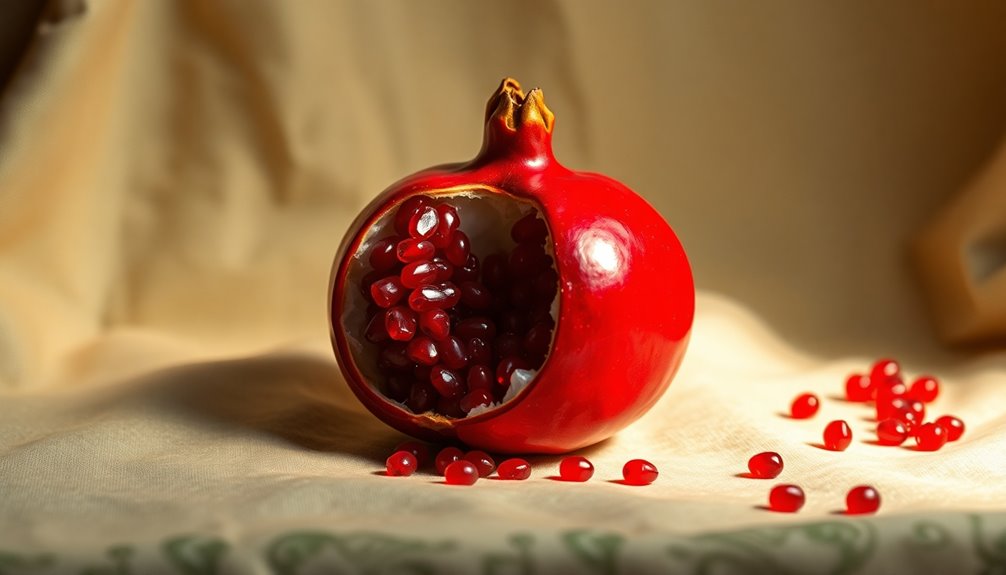
The pomegranate is a fascinating fruit with rich cultural meanings that can surprise you!
In many traditions, it stands for fertility and new beginnings, making it a popular choice in wedding celebrations.
It also carries deep religious significance, symbolizing moral duties and spiritual awakening across various cultures.
Fertility and Rebirth Symbolism
Pomegranates burst with symbolism, particularly in their association with fertility and rebirth across various cultures. This vibrant fruit, filled with juicy seeds, represents the abundance of life.
In Jewish tradition, pomegranates symbolize spiritual fertility, as they stand for the 613 commandments of the Torah. Each seed reflects a chance for moral growth and a deeper connection to one's faith.
In Greek mythology, the pomegranate is tied to the story of Persephone. When she eats its seeds, it marks her journey between the underworld and the living world, symbolizing renewal and the changing seasons. This cycle of life is a beautiful reminder of rebirth.
In many Middle Eastern cultures, pomegranates play an important role in bridal rituals. Here, they symbolize the hope for children and a fruitful marriage.
Historically, ancient Sumerians and Egyptians also saw the pomegranate as a sacred symbol of life and rebirth. It embodies divine femininity and the nurturing aspects of motherhood.
Religious and Mythological Significance
Throughout history, the pomegranate has woven itself into the fabric of various religions and mythologies, serving as a powerful symbol of life, death, and rebirth. This vibrant fruit carries deep meanings, especially in the context of ancient cultures.
- In Greek mythology, it's linked to Persephone, the goddess of spring.
- In Jewish tradition, it symbolizes the 613 commandments of the Torah, highlighting moral duties.
- The Koran mentions it as a symbol of paradise, reflecting blessings from nature.
In the ancient Greek myth, when Persephone eats the pomegranate seeds, she's tied to the underworld for part of the year. This story shows the fruit as a symbol of fertility, representing the cycles of life and nature.
Its many seeds remind us of abundance and growth, making it a cherished motif in art and literature.
Across cultures, the pomegranate stands out as a beautiful reminder of the connections between life and death. It invites you to explore the richness of tradition, inspiring a sense of wonder about the world around you.
Physical and Culinary Characteristics

Bursting with jewel-like arils, pomegranates captivate both the eye and the palate. These beautiful fruits are filled with pomegranate seeds, also known as arils, which are shaped like tiny jewels. When you bite into these juicy seeds, you'll taste a delightful mix of sweetness and tanginess that makes pomegranates so special.
Pomegranates are usually harvested in the fall, and they add a pop of color and flavor to many dishes. You can find them in Mediterranean and Middle Eastern cuisines, where they enhance salads, desserts, and even drinks. Imagine using pomegranate juice in a salad dressing or as a marinade for meat—it's simply delicious!
To enjoy pomegranates, you'll need to cut the fruit open and gently press it to release the juice while keeping as many seeds intact as possible. This way, you minimize waste and get to enjoy those precious, juicy seeds.
Whether you eat them fresh or use them in recipes, pomegranates are a treat that brings joy to your meals. So, why not plunge into the world of pomegranates and discover their exciting flavors?
Health Benefits and Medicinal Uses
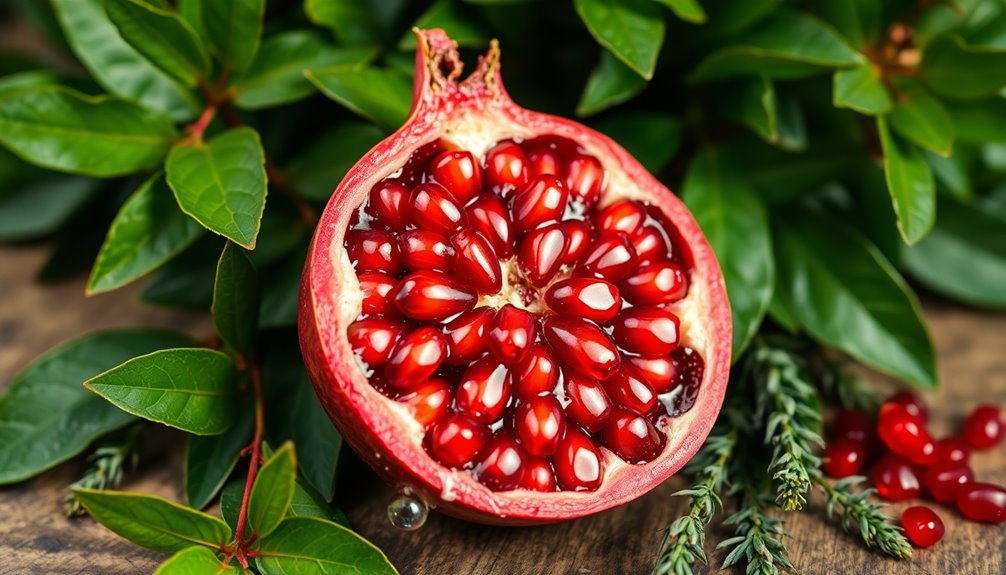
While you might enjoy the delicious taste of pomegranates, their health benefits are equally impressive. This vibrant fruit is packed with nutrients that can boost your life and fertility. Here are a few reasons to add pomegranates to your diet:
- They're rich in antioxidants, which help fight oxidative stress and inflammation.
- Pomegranate juice may lower blood pressure and cholesterol, supporting heart health.
- The fruit contains compounds that can protect your brain and enhance cognitive function.
Not only are pomegranates low in calories, but they're also high in fiber, making them a great choice for weight management and digestive health.
Plus, research suggests that pomegranate extracts might even help prevent certain cancers. Isn't that amazing? Additionally, incorporating raw fruits and vegetables into your diet, like pomegranates, can further enhance your overall health and well-being.
Incorporating pomegranates into your meals can be as simple as adding them to salads, smoothies, or desserts.
You'll enjoy their juicy bursts of flavor while reaping their numerous health benefits.
Economic and Environmental Impact
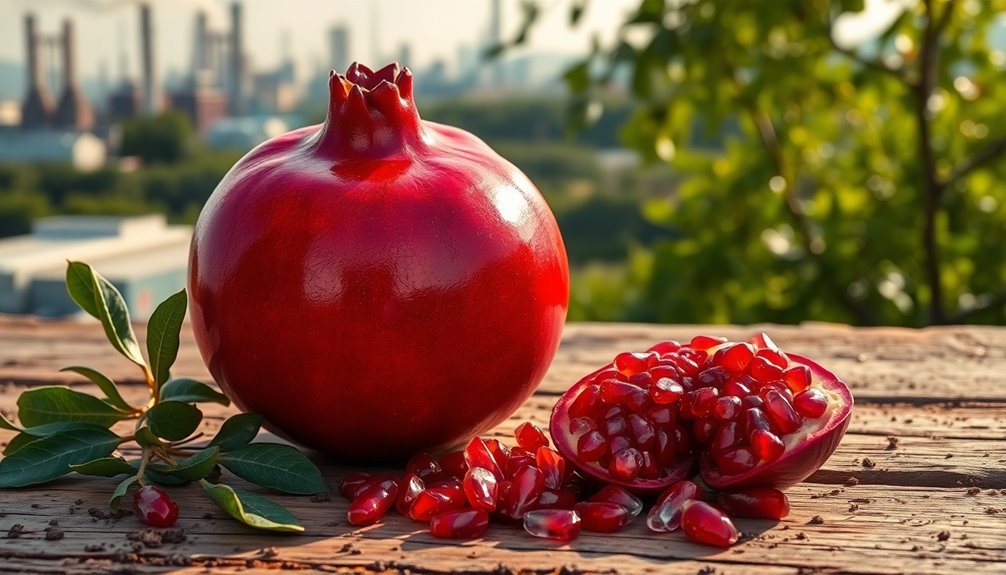
The economic and environmental impact of pomegranates is significant, reflecting their growing popularity in the global market. By 2025, the global pomegranate market is expected to be worth around $4 billion! This rise is mainly due to more people wanting healthy foods. Major producers like India, Iran, and the United States are leading the way, with Iran being the biggest exporter.
Pomegranate cultivation plays a crucial role in supporting agricultural economies and creating jobs in these regions, highlighting its economic significance.
On the environmental side, pomegranate trees are fascinating. They can grow up to 5 meters tall and live for an incredible 200 years! This long lifespan shows their agricultural viability and helps improve biodiversity.
Plus, pomegranates don't need as much water as other fruits, making them a more sustainable choice for farmers in different climates. Growing pomegranates not only brings delicious fruit to our tables but also supports the environment.
Artistic Interpretations
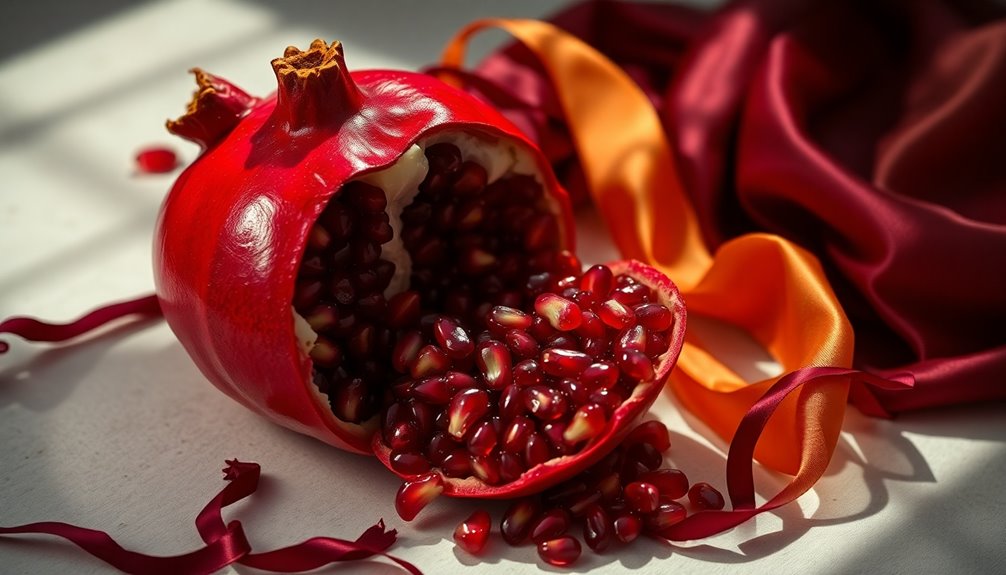
Let's explore how artists use the pomegranate in their work!
You'll find it pops up in contemporary art, literature, and beautiful tapestries.
From symbols of fertility and beauty to deeper themes of life and renewal, the pomegranate really sparks creativity and imagination!
Pomegranate in Contemporary Art
Contemporary art often draws on the rich symbolism of the pomegranate, weaving its imagery into various forms to explore themes of fertility, sensuality, and the interplay between life and death. Artists love using this vibrant fruit often because it sparks deep thoughts and feelings.
- The bright red color of the pomegranate captures attention, celebrating life and liveliness.
- Its many seeds represent abundance and the beauty of nature, reminding us of growth.
- Abstract interpretations allow viewers to connect emotionally and spiritually, encouraging personal reflection.
In modern times, the pomegranate serves as a metaphor for personal awakening and empowerment. This fruit often challenges old ideas about femininity and sexuality, making it a powerful symbol.
You might see pomegranate motifs in paintings, textiles, and even logos. These artistic choices highlight the fruit's significance in today's society.
Each artwork invites you to think about life's duality—how beauty can exist alongside hardship. So, next time you spot a pomegranate in art, remember it's more than just a fruit. It's a vibrant symbol that celebrates life, joy, and the complexities within us all!
Symbolism in Literature
Often, writers incorporate the pomegranate in their narratives to explore complex themes of temptation and consequence. This vibrant fruit offers a rich tapestry of meanings. For example, in the myth of Persephone, the pomegranate represents both fertility and death, highlighting life's dual nature.
You might notice the pomegranate tree appearing in stories to symbolize abundance and life. Its bright red color and many seeds can represent passion and sensuality too.
Angela Carter, a fascinating author, dives into the pomegranate's symbolism, linking it to ideas of empowerment and the complexities of femininity.
In Jewish tradition, the seeds of the pomegranate are a beautiful metaphor for the richness of knowledge. They remind us of the importance of studying the Torah and living a moral life.
When you read about pomegranates alongside mythological figures, you see how they symbolize unity and the cycles of life.
Cultural Motifs and Tapestries
Throughout history, artists have employed pomegranate motifs in their work to convey deep cultural meanings, intertwining themes of life, death, and fertility. You can see these vibrant symbols in beautiful tapestries, especially from the Middle Ages. Pomegranates aren't just pretty; they carry rich stories and emotions.
- They symbolize fertility and abundance, reminding us of nature's gifts.
- In Persian velvet tapestries, pomegranates represent love and sensuality, adding a touch of romance.
- Artists often capture the dual nature of life and death with pomegranate imagery, making their work deeply significant.
Imagine a tapestry adorned with bright red pomegranates, their jewel-like seeds glimmering in the light. Each seed tells a story of hope and liveliness.
These motifs often appear in religious textiles, symbolizing protection and prosperity. When you think of pomegranates in art, remember that they reflect a connection to the divine and celebrate sacred femininity.
The next time you see a tapestry featuring pomegranates, take a moment to appreciate the beauty and symbolism woven into the fabric. It's like a treasure chest of meaning waiting to be discovered!
Frequently Asked Questions
What Does the Pomegranate Symbolize?
The pomegranate symbolizes many wonderful things! It often represents fertility and abundance, which is why it's linked to celebrations and new beginnings.
In different cultures, it stands for life and death, reminding us of renewal and sacrifice. It also connects to important moral ideas, showing how we should fulfill our duties.
Plus, it's seen as a sacred fruit, symbolizing paradise and immortality. Isn't it amazing how one fruit can mean so much?
What Goddess Is the Pomegranate a Symbol Of?
The pomegranate is a symbol of several powerful goddesses!
It's closely linked to Persephone, the Greek goddess of spring and the underworld. When she eats its seeds, it represents her connection to life and rebirth.
You'll also find it associated with Inanna, the Sumerian goddess of love and war, showcasing femininity and desire.
Plus, it connects to Venus, the Roman goddess of love, symbolizing beauty and abundance.
Isn't that fascinating?
What Is the Full Meaning of Pomegranate?
The pomegranate is a fascinating fruit!
It's packed with juicy seeds that burst with flavor. Full of vitamins, it's great for your health.
In many cultures, it represents life and abundance. You might see it in art or stories, symbolizing love and fertility.
Some believe it holds 613 seeds, linking it to important traditions.
What Do Pomegranates Symbolize in the Bible?
Have you ever wondered why pomegranates pop up so often in the Bible? They symbolize fertility and abundance, representing the richness of the Promised Land.
You'll find them linked to the 613 commandments of the Torah, as they're said to have that many seeds!
In addition, they appear on the High Priest's garments, signifying holiness.
Conclusion
To sum up, pomegranates are much more than just tasty fruits! They hold deep meanings in myths and cultures around the world. Imagine a school project where kids create art inspired by the pomegranate's bright red seeds. This could spark conversations about its symbolism and health benefits, making learning fun! So, whether you enjoy them in a salad or as juice, remember that pomegranates are a delightful blend of history, health, and happiness just waiting to be explored!





